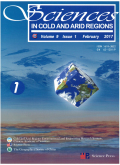- 钛学术文献服务平台 \
- 学术期刊 \
- 基础科学期刊 \
- 天文学、地球科学期刊 \
- 寒旱区科学(英文版)期刊 \
Numerical simulation of vibrational response characteristics of railway subgrades with insulation boards
Numerical simulation of vibrational response characteristics of railway subgrades with insulation boards
基本信息来源于合作网站,原文需代理用户跳转至来源网站获取
摘要:
This study presents a numerical method based on the surface temperature data and the ground temperature increase in Daq-ing for predicting temperature field distribution in the Binzhou Railway subgrade and analyzing the temporal and spatial distribution of freeze?thaw status of railway subgrade. The calibrated numerical method is applied to simulate the temper-ature field distribution and roadbed vibrational response of the railway subgrade with a thermal insulation layer at differ-ent seasons. The results show the following:(1) The thermal insulation layer can remarkably increase the soil temperature below it and maximum frost depth in the subgrade. (2) Thermal insulation can effectively reduce the subgrade vibration and protect it from frost damage. (3) Given that the strength requirements are met, the insulation layer should be buried as shallow as possible to effectively reduce the subgrade vibration response. The research findings provide theoretical sup-port for the frost damage prevention of railway subgrades in seasonally frozen regions.

推荐文章
Adsorption characteristics of copper ion on nanoporous silica
Nanoporous silica
Copper ion
Adsorption
基于Plant Simulation的离散制造系统仿真研究
离散制造系统
建模仿真
系统仿真
仿真模型
The occurrences and geochemical characteristics of thorium in iron ore in the Bayan Obo deposit, Nor
Thorium
Occurrence state
Distribution law
Geochemical characteristics
Iron ore
Bayan Obo deposit
内容分析
关键词云
关键词热度
相关文献总数
(/次)
(/年)
文献信息
| 篇名 | Numerical simulation of vibrational response characteristics of railway subgrades with insulation boards | ||
| 来源期刊 | 寒旱区科学(英文版) | 学科 | |
| 关键词 | |||
| 年,卷(期) | 2022,(1) | 所属期刊栏目 | Articles |
| 研究方向 | 页码范围 | 23-31 | |
| 页数 | 9页 | 分类号 | |
| 字数 | 语种 | 英文 | |
| DOI | |||
五维指标
引文网络
引文网络
二级参考文献 (0)
共引文献 (0)
参考文献 (0)
节点文献
引证文献 (0)
同被引文献 (0)
二级引证文献 (0)
2022(0)
- 参考文献(0)
- 二级参考文献(0)
- 引证文献(0)
- 二级引证文献(0)
引文网络交叉学科
相关学者/机构
期刊影响力
寒旱区科学(英文版)
主办单位:
中国科学院寒区旱区环境与工程研究所
科学出版社有限责任公司
出版周期:
双月刊
ISSN:
1674-3822
CN:
62-1201/P
开本:
出版地:
甘肃省兰州市东岗西路320号
邮发代号:
创刊时间:
语种:
eng
出版文献量(篇)
870
总下载数(次)
0
总被引数(次)
1072
期刊文献
相关文献
推荐文献
- 期刊分类
- 期刊(年)
- 期刊(期)
- 期刊推荐
力学
化学
地球物理学
地质学
基础科学综合
大学学报
天文学
天文学、地球科学
数学
气象学
海洋学
物理学
生物学
生物科学
自然地理学和测绘学
自然科学总论
自然科学理论与方法
资源科学
非线性科学与系统科学
寒旱区科学(英文版)2022
寒旱区科学(英文版)2021
寒旱区科学(英文版)2020
寒旱区科学(英文版)2019
寒旱区科学(英文版)2018
寒旱区科学(英文版)2017
寒旱区科学(英文版)2016
寒旱区科学(英文版)2015
寒旱区科学(英文版)2014
寒旱区科学(英文版)2013
寒旱区科学(英文版)2012
寒旱区科学(英文版)2011
寒旱区科学(英文版)2010
寒旱区科学(英文版)2009
寒旱区科学(英文版)2008

 免费查重
免费查重










